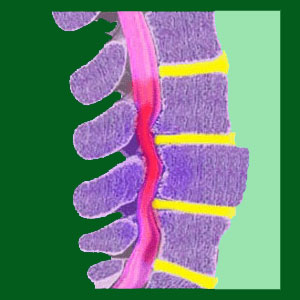
Spondylolisthesis nerve damage can result from impingement of the nerve roots in the central vertebral or foraminal canals. Nerve damage is a legitimate threat in cases of advanced listhesis, since the condition can misalign the central canal and neuroforamen to the extent of pinching nerve tissues and creating compressive neuropathy syndromes.
Nerve damage is a topic of great interest for us at The Cure Back Pain Network and a subject that we have covered extensively in the past. We continue to be fascinated by the frequent incidence of bogus threats of nerve damage that are thrown about casually by care providers throughout the back and neck pain treatment sector. However, when it comes to severe high grade listhesis, these threats might just become reality for patients who do not receive the care that they require in order to protect neurological functionality throughout their spines.
This important essay investigates the possibility of suffering nerve damage due to vertebral migration. We will examine how and why nerve trauma might occur in the neck and lower back regions, as well as what can be done to correct damage to the spinal nerve roots during treatment.
Spondylolisthesis Nerve Damage in the Central Canal
In the neck, spinal nerves can be compressed within the central vertebral canal or within the lateral recess when they separate from the spinal cord and seek egress through the neural foramen. When a nerve is compressed in such a manner, symptoms will exist identically to foraminal stenosis that compresses a nerve root. However, this event is rare and often resolves organically, typically being a transient condition.
In the lumbar spine, compression of individual nerve roots or the entire cauda equina nerve root bundle can be compressed within the central canal. This requires a significant degree of spondylolisthesis, often high grade 3 or grade 4 classifications. Additionally, there are usually other contributors to spinal nerve root compression in the vicinity, such as degenerative disc disease, herniated lumbar discs, general spinal canal osteoarthritis and possible changes to the usual curvature in the lower back, as well. Massed nerve root compression can create cauda equina syndrome, which is a medical emergency that can lead to spinal nerve damage, incontinence and eventual paralysis.
Spondylolisthesis Foraminal Canal Nerve Injury
Pinched nerves can occur in the neural foramen as they attempt to exit from the spinal anatomy. Both cervical and lumbar foraminal stenosis are common results of moderate, severe and extreme spondylolisthesis, and can facilitate compressive neuropathy issues throughout the vertebral column.
When listhesis is severe, the foraminal spaces between vertebral bones will not align correctly and this may cause a reduction in effective size of these foraminal openings. When the neural foramen become virtually closed off, the chances for a pinched nerve occurring are likely.
In some situations where acute, sudden listhesis occurs, nerve roots might actually be torn or severed within the foraminal spaces as the opposing vertebral edges act as a shape edge to injure the nerve tissues. This is most often seen in cases of massive trauma, such as after motor vehicle collisions.
Spondylolisthesis Nerve Damage Consequences
Spinal nerves are very delicate and damage might involve permanent changes to their ability to signal correctly between the brain and the body. However, in many cases, if a compressive neuropathy condition is rectified, the nerve will resume normal or near-normal function after a period of healing and sometimes immediately.
In cases where trauma leaves lasting effects, patients might suffer loss of innervation functionality in specific parts of the body. This might affect motor function of the muscles, sensation of the tissues or autonomic processes. In extreme cases, patients might suffer paralysis of these same innervated areas if there is no nerve signal at all providing feedback between the brain and the anatomical location.
Spondylolisthesis > Consequences of Spondylolisthesis > Spondylolisthesis Nerve Damage



